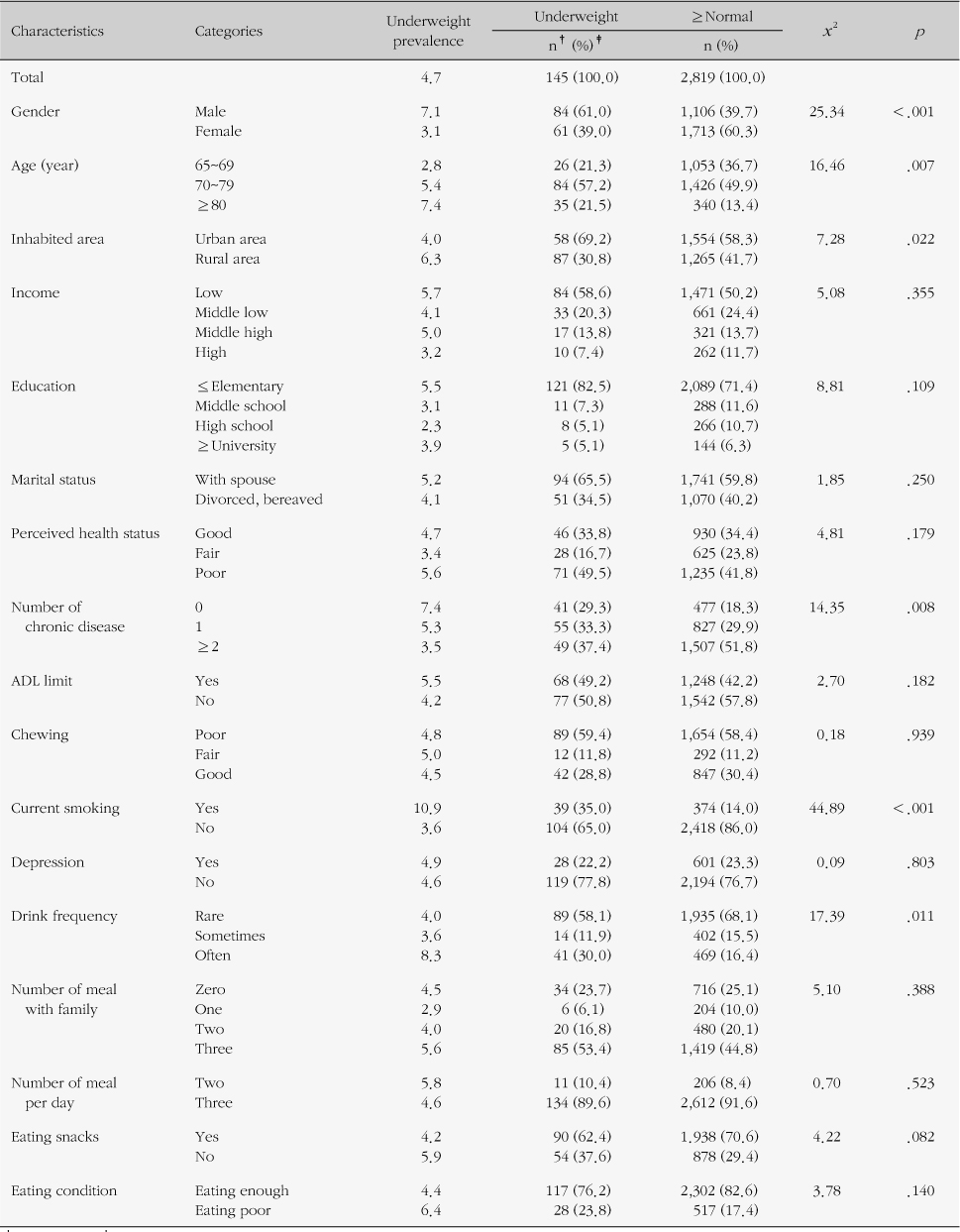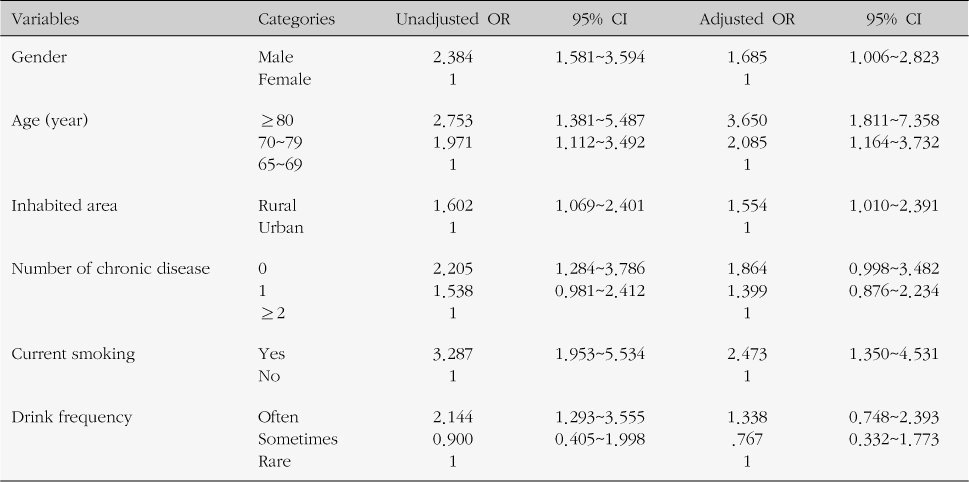References
1. Albanes D, Jones D, Micozzi MS, Mattson ME. Associations between smoking and body weight in the US population: Analysis of NHANES II. Am J Public Health 1987;77(4):439–444.
2. Barreto SM, Passos V, Lima-Costa MF. Obesity and underweight among brazilian elderly: The bambui health and aging study. Cad Saude Publica 2003;19(2):605–612.
3. Chapman IM. Obesity paradox during aging. Interdiscip Top Gerontol 2010;37:20–36.
4. Cho YH. A study on the related factors and status of body mass index in rural elderly. J Korean Gerontol Soc 2007;27(4):897–912.
5. Cope K. Malnutrition in the elderly: A national crisis: A focus on the problems, causes, consequences, and solutions Seattle: DIANE; 1996.
6. Corrada MM, Kawas CH, Mozaffar F, Paganini-Hill A. Association of body mass index and weight change with all-cause mortality in the elderly. Am J Epidemiol 2006;163(10):938–949.
7. Donini LM, Savina C, Cannella C. Eating habits and appetite control in the elderly: The anorexia of aging. Int Psychogeriatr 2003;15(1):73–87.
8. Dorner TE, Schwarz F, Kranz A, Freidl W, Rieder A, Gisinger C. Body mass index and the risk of infections in institutionalised geriatric patients. Br J Nutr 2010;103(12):1830–1835.
9. Kaiser R, Winning K, Uter W, Volkert D, Lesser S, Stehle P, et al. Functionality and mortality in obese nursing home residents: An example of 'risk factor paradox'? J Am Med Dir Assoc 2010;11(6):428–435.
10. Kitamura K, Nakamura K, Nishiwaki T, Ueno K, Hasegawa M. Low body mass index and low serum albumin are predictive factors for short-term mortality in elderly japanese requiring home care. Tohoku J Exp Med 2010;221(1):29–34.
11. Korea Centers for Disease Control and Prevention. The Third Korea National Health and Nutrition Examination Survey [KNHANES III] 2006. 07. Retrieved August 22, 2011. from
http://knhanes.cdc.go.kr/.
12. Korea Centers for Disease Control and Prevention. The Fourth Korea National Health and Nutrition Examination Survey [KNHANES IV-3] 2010. 12. Retrieved August 22, 2011. from
http://knhanes.cdc.go.kr/.
13. Korea National Statistical Office. Census of elderly population in Korean 2010 year Seoul: Korea National Statistical Office; 2010. 10.
14. Lee SG, Jeon SY, Lee JY. Factors related with low body weight in older adults at a urban-rural composite area. J Korean Gerontol Soc 2008;28(1):105–121.
15. Lee JH. Effect of body weight on mental health in the elderly. J Korean Geriatr Psychiatry 2004;8:102–106.
16. Lewko M, Chamseddin A, Zaky M, Birrer RB. Weight loss in the elderly: What's normal and what's not. P T 2003;28(11):734–739.
17. Manson JE, Willett WC, Stampfer MJ, Colditz GA, Hunter DJ, Hankinson SE, et al. Body weight and mortality among women. N Engl J Med 1995;333(11):677–685.
18. Martin CT, Kayser-Jones J, Stotts N, Porter C, Froelicher ES. Factors contributing to low weight in community-living older adults. J Am Acad Nurse Pract 2005;17(10):425–431.
19. Thompson Martin C, Kayser-Jones J, Stotts N, Porter C, Froelicher ES. Nutritional risk and low weight in community-living older adults: A review of the literature (1995-2005). J Gerontol A Biol Sci Med Sci 2006;61(9):927–934.
20. Martin CT, Kayser-Jones J, Stotts NA, Porter C, Froelicher ES. Risk for low weight in community-dwelling, older adults. Clin Nurse Spec 2007;21(4):203–211.
21. Miller SL, Wolfe RR. The danger of weight loss in the elderly. J Nutr Health Aging 2008;12(7):487–491.
22. Mineur YS, Abizaid A, Rao Y, Salas R, DiLeone RJ, Gündisch D, et al. Nicotine decreases food intake through activation of POMC neurons. Science 2011;332(6035):1330–1332.
23. Morley JE. Anorexia, sarcopenia, and aging. Nutrition 2001;17(7-8):660–663.
24. Nielson CM, Marshall LM, Adams AL, LeBlanc ES, Cawthon PM, Ensrud K. BMI and fracture risk in older men: The osteoporotic fractures in men study (MrOS). J Bone Miner Res 2011;26(3):496–502.
25. Shahar A, Shahar D, Kahar Y, Nitzan-Kalusky D. Low-weight and weight loss as predictors of morbidity and mortality in old age. Harefuah 2005;144(6):443–448.
26. Vermeulen J, Neyens JC, van Rossum E, Spreeuwenberg MD, de Witte LP. Predicting ADL disability in community-dwelling elderly people using physical frailty indicators: A systematic review. BMC Geriatr 2011;11:33.

